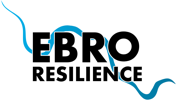The LIFE Ebro Resilience P1 Project maintains its commitment to participation in interventions to reduce flood risk. On Monday, August 7, technicians of the Hydrographic Confederation of the Ebro and Environmental Management of Navarre (GAN-NIK) held an informative meeting with representatives of the Town Councils of Valtierra, Cadreita and Castejón, which was represented by its mayoress Noelia Guerra, to inform about the status of the processing of the works of the morphological adaptation and environmental restoration of the meander of El Señorío, in Castejón, Navarre.
This intervention, with a budget of €1.8 million, is part of Zone 1 of the LIFE Project, which designs actions to mitigate the risk of flooding in the Alfaro (La Rioja) – Castejón (Navarra) section.
In addition to this meeting with the representatives of the Consistories, a public information day has been organized for the first week of September, which will include a visit to the intervention area. The organizational details of this event, as well as the registration forms, will be available to the public in the participation section of our website.

The project that defines the intervention has been exposed to interested parties and the general public for a month, so that they could make comments, observations, suggestions or allegations to the proposed actions.
During the public information period, an allegation was received warning of the possibility that the projected works could affect the archaeological sites of “El Montecillo” and “El Cerro del Castillo”, located on the elevated land next to the meander. After submitting all available information to the Department of Culture and Sports of the Government of Navarra, the Historical Heritage Service has issued a favorable report on the actions defined in the project, indicating that no impact on the sites is foreseen.
The objectives del proyecto son reduce the risk of flooding throughout the entire stretch; return the meander to its natural functions in terms of the recovery of river dynamics and the evacuation of flows in flood situations, and to prevent deterioration, protect and improving the state of ecosystems aquatic, terrestrial and wetlands.
To this end:
- River space will be recovered with the removal of 1.3 km of the existing perimeter dike in the meander.
- A relief channel will be created, an additional branch to the Ebro River, which will divert part of the flows in circulation during floods.
- The meander will be restored with plantations that promote and accelerate natural revegetation; exotic plant species will be eliminated; the recovery of habitats for fauna species of interest and the inclusion of elements to bring the space closer to the population will be promoted.
- The natural enclaves preserved on the left bank will be connected, forming three ecological corridors that connect them with each other and with the Sotos de Alfaro Nature Reserve, located upstream, and the Ebro River ZEC, located downstream.
This restoration is part of the so-called “Combined section of actions” of the LIFE Project, which defines a series of natural water retention measures that will generate an overall benefit with respect to flood risk and the environmental condition of the riverbed in the section of the Ebro River that runs between Alfaro (La Rioja) and Castejón (Navarra). These measures include: reconnection of meanders, relief channels, rehabilitation of lost river branches and recovery of river space such as flood plains.
El Señorío will be added to the work in progress in the meander of La Roza, in Alfaro, a work also included in the LIFE Project, and to the actions in the meanders of El Ortigoso, La Nava and El Estajao, also in the Ebro River as it passes through the municipalities of Milagro (Navarra) and Alfaro, carried out in accordance with the criteria of the Ebro Resilience Strategy.
In the combined section of actions, the morphological adaptation works will be carried out by the CHE and the environmental restoration works by the Autonomous Governments of La Rioja, in the case of La Roza, and Navarra, the latter through its public company GAN-NIK, in the case of El Señorío.

LIFE Project
The LIFE Ebro Resilience P1 Project (LIFE20 ENV/ES/00327), approved by the European Commission in the LIFE 2020 call, covers three autonomous communities (La Rioja, Navarra and Aragón), has a duration of 6 years and a total budget of 13,310,350 €, with 55% European funding.
This Project is also an example of institutional coordination and cooperation in the intervention section, being its partners the Ministry for Ecological Transition and Demographic Challenge (MITECO), through its companies TRAGSA and TRAGSATEC; the Ebro Hydrographic Confederation; the Government of La Rioja; the Government of Navarra, through Gestión Ambiental de Navarra, S.A. (GAN-NIK); the Government of Aragón and the Aragonese Water Institute.

